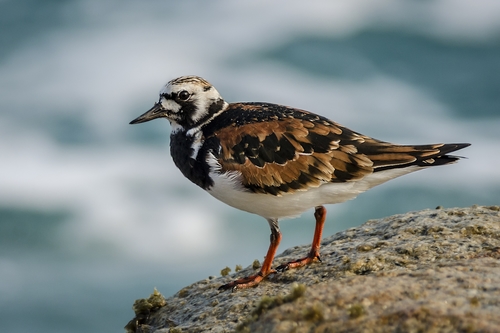
Ruddy Turnstone
The Ruddy Turnstone (Arenaria interpres) is a small, stocky shorebird known for its striking breeding plumage and unique foraging behavior. It plays an important ecological role as a predator of invertebrates in coastal ecosystems, helping to regulate their populations. It is a highly migratory species, undertaking long journeys between its Arctic breeding grounds and coastal wintering areas across the globe. The name "turnstone" derives from its characteristic habit of flipping over stones, shells, and seaweed in search of prey.
21-26 cm
Length
43-50 cm
Wingspan
Least Concern
Conservation Status
Distribution
Breeds in the high Arctic regions of North America, Europe, and Asia. Winters along coastlines worldwide, including North and South America, Europe, Africa, Asia, Australia, and many Pacific islands. Migratory routes are extensive and often follow coastlines.
Lifespan
Average lifespan in the wild is around 9 years, with a maximum recorded lifespan of over 19 years.
Ruddy Turnstone's Habitat
Habitat Types
Rocky shores, Sandy beaches, Mudflats, Tundra (breeding), Coastal lagoons, Salt marshes
Climate Zones
Arctic (breeding), Temperate, Tropical, Subtropical
Adaptations
Ruddy Turnstones have slightly upturned, chisel-like bills perfectly adapted for flipping stones and other objects. Their strong legs and feet allow them to navigate rocky and uneven terrain. Their plumage provides camouflage in their respective habitats.
Variations
Two subspecies are generally recognized: *Arenaria interpres interpres* and *Arenaria interpres morinella*. *A. i. morinella* breeds in North America and is slightly smaller and darker than *A. i. interpres*, which breeds in Eurasia.
Appearance
Breeding Plumage
Breeding plumage is striking, with a black-and-white patterned head, orange-red back and wings, and a black breast band. Non-breeding plumage is duller, with a brownish-gray head and back and a less distinct breast band.
Seasonal Feather Changes
Significant seasonal variation. Molt occurs twice a year, transitioning between the bright breeding plumage in spring and the more cryptic non-breeding plumage in fall.
Sex Based Plumage Differences
Males tend to have slightly brighter breeding plumage than females, but the difference is subtle.
Notable Features
Short, slightly upturned bill, Orange-red legs, Distinctive black-and-white head pattern (breeding plumage), Bold white wing bars and rump visible in flight
Diet and Feeding
Primary Foods
Insects, Crustaceans, Mollusks, Worms, Small fish, Eggs (of other birds or invertebrates), Carrion, Seeds (occasionally)
Foraging Behavior
Famous for its habit of turning over stones, shells, and seaweed with its bill to find prey underneath. Also probes in sand and mud, and sometimes catches insects in flight.
Specializations
The bill shape is a key specialization, allowing it to pry and flip objects effectively. They also have a strong gizzard to help process hard-shelled prey.
Seasonal Diet Variations
Diet varies depending on location and season. During the breeding season, insects form a major part of the diet. In winter, they consume a wider variety of invertebrates found along the coast.
Behavior
Social Structure
Generally found in small flocks during migration and winter. During the breeding season, they are territorial and defend their nesting areas.
Communication
A variety of calls, including a sharp "kew-kew" and a rattling trill., Visual displays, such as wing-raising and head-bobbing.
Migration
Long-distance migrants. Some populations travel thousands of kilometers between breeding and wintering grounds. They are known for their navigational abilities, often returning to the same breeding and wintering sites year after year.
Territorial or Group Behaviors
Territorial during breeding, defending nesting sites from other turnstones and potential predators. Outside of the breeding season, they are more gregarious and form flocks, sometimes mixed with other shorebird species.
Conservation
Threats
Habitat loss and degradation (coastal development, pollution), Climate change (sea-level rise, changes in prey availability), Disturbance at breeding and wintering sites (human activity, introduced predators), Over-harvesting of horseshoe crab eggs (an important food source during migration in some areas)
Protection Programs
International agreements (e.g., Ramsar Convention on Wetlands), Designation of protected areas (e.g., national parks, wildlife refuges), Monitoring programs to track population trends
Local National Laws
Protected under various national and international laws, such as the Migratory Bird Treaty Act in the United States and the Agreement on the Conservation of African-Eurasian Migratory Waterbirds (AEWA).
Population Trend
Stable
Population Estimates
The global population is estimated to be around 445,000 - 735,000 individuals.
Interesting Facts
They are incredibly strong for their size.
Ruddy Turnstones have been observed flipping stones weighing up to 50 grams, more than half their own body weight.
They are highly adaptable.
Their ability to utilize a wide range of coastal habitats and food sources contributes to their widespread distribution.
Some individuals undertake remarkable migrations.
Some Ruddy Turnstones breeding in Alaska migrate to Hawaii and other Pacific islands, a journey of thousands of kilometers over open ocean.
Faqs about Ruddy Turnstone
Where can I see Ruddy Turnstones?
Look for them along coastlines during migration and winter. They are often found on rocky shores, beaches, and mudflats.
What is the difference between breeding and non-breeding plumage?
Breeding plumage is much more colorful and patterned, with a black-and-white head, orange-red back, and black breast band. Non-breeding plumage is duller and browner.
Are Ruddy Turnstones endangered?
No, they are currently classified as Least Concern by the IUCN. However, their populations are facing threats from habitat loss and climate change.
How do they find their food?
They use their specialized bills to flip over stones, shells, and seaweed, revealing the invertebrates hiding underneath.
Copyright @ Nature Style Limited. All Rights Reserved.
 English
English